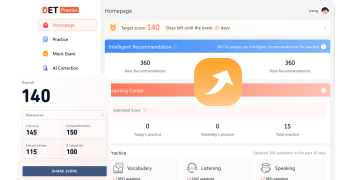듀오링고 영어 시험의 "읽고, 그 후 말하기" 섹션 마스터 하기
듀오링고 영어 테스트는 온라인으로 영어 능력을 평가하는 편리하고 저렴한 방법입니다. 다른 표준화된 시험과 달리, 듀오링고 영어 테스트는 수험자의 수준과 능력에 맞게 조정되는 독특한 형식을 가지고 있습니다. 이 시험에서 가장 도전적이고 중요한 부분 중 하나는 “Read, Then Speak” 섹션입니다. 여기서는 주제를 읽은 후 90초 동안 해당 주제에 대해 말해야 합니다.
이 기사에서는 이 섹션을 성공적으로 통과하고 회화 및 생산 점수를 향상시키는 방법을 보여드리겠습니다.
다음 내용을 다루겠습니다:
- “Read, Then Speak” 형식 이해하기
- 답변 준비하기
- 답변 구조화하기
- 답변 전달하기
- 답변 향상시키기
- 샘플 질문 및 데모 답변 포함하기
- 연습 팁 및 리소스

“Read, Then Speak” 형식 이해하기
“Read, Then Speak” 섹션은 듀오링고 영어 테스트의 네 가지 말하기 과제 유형 중 하나입니다. 이 섹션에서는 “아래 주제에 대해 90초 동안 말하십시오.”라고 요구합니다.
이 질문 유형에서는 화면에 쓰여진 프롬프트를 보게 됩니다. 프롬프트를 읽고 답변을 준비할 시간은 20초입니다. 그런 다음 테스트는 자동으로 녹화 화면으로 전환되며, 여기서 90초 동안 답변을 말하게 됩니다. 프롬프트를 말하면서도 여전히 볼 수 있습니다.
프롬프트는 보통 개인적인 경험, 의견 또는 선호도에 대해 이야기하도록 요청합니다. 예를 들어:
- 당신이 가장 좋아하는 레스토랑에 대해 이야기하세요.
- 어려운 결정을 내려야 했던 때에 대해 논의하세요.
- 즐기는 취미를 설명해 보세요.
프롬프트에는 답변을 안내하는 몇 가지 포인트도 포함될 것입니다. 예를 들어:
- 그것은 어디에 있나요?
- 어떤 종류의 음식을 제공하나요?
- 얼마나 자주 가나요?
- 왜 그것이 당신의 가장 좋아하는 곳인가요?
당신의 답변은 두 가지 하위 점수로 평가됩니다: 회화와 생산. 회화는 질문과 잘 상호 작용하고 아이디어를 표현하는 능력을 측정합니다. 생산은 어휘와 문법을 사용하여 명확하고 정확하게 의사소통하는 능력을 측정합니다.
답변 준비하기
성공적인 답변의 핵심은 프롬프트를 빠르게 이해하고 짧은 시간 내에 생각을 정리하는 것입니다. 준비를 도울 몇 가지 전략은 다음과 같습니다:
- 프롬프트를 주의 깊게 읽고 주요 주제와 하위 주제를 식별하세요. 예를 들어, 프롬프트가 “당신이 가장 좋아하는 레스토랑에 대해 이야기하세요.”일 경우, 주요 주제는 당신이 가장 좋아하는 레스토랑이며, 하위 주제는 그곳이 어디인지, 어떤 종류의 음식을 제공하는지, 얼마나 자주 가는지, 그리고 왜 그것이 당신의 가장 좋아하는 곳인지입니다.
- 주요 주제와 관련된 구체적인 예를 생각해보세요. 예를 들어, 당신의 가장 좋아하는 레스토랑이 집 근처의 태국 음식점일 경우, 친구나 가족과 함께 갔던 기억에 남는 순간을 생각해보세요.
- 포인트를 사용하는 가이드로 답변을 구조화하세요. 예를 들어, 가장 좋아하는 레스토랑을 소개하는 것으로 시작한 다음 각 포인트를 차례대로 이야기하고, 주요 요점을 요약하는 결론으로 끝낼 수 있습니다.
- 준비 시간 20초를 효과적으로 사용하세요. 주요 요점을 기억하는 데 도움이 되는 몇 가지 키워드를 찾을 수 있습니다. 또한 자신감을 가지고 시작하기 위해 답변의 첫 문장을 연습할 수도 있습니다.
답변 구조화하기
명확하고 논리적인 답변 구조는 답변을 원활하고 일관되게 전달하는 데 도움이 됩니다. 답변을 구조화하는 몇 가지 팁은 다음과 같습니다:
- 서론, 본론, 결론을 만드세요. 서론에서는 주요 주제를 간략하게 소개하고 주요 요점을 언급해야 합니다. 본론에서는 각 하위 주제를 자세히 설명하여 주요 요점을 발전시켜야 합니다. 결론에서는 주요 요점을 요약하고 마지막 발언으로 마무리해야 합니다.
- 아이디어와 문장을 연결하기 위해 전환 단어와 구문을 사용하세요. 예를 들어, “first”, “second”, “third”, “next”, “then”, “finally”, “also”, “however”, “for example”, “in conclusion”, 등의 단어를 사용할 수 있습니다.
- 프롬프트의 모든 부분을 다루세요. 아무 포인트도 건너뛰거나 무시하지 않도록 하세요. 하위 주제에 대해 할 말이 없다면 간단히 언급하고 넘어갈 수 있습니다. 예를 들어, “I don’t go there very often, but when I do, I always enjoy it.”라고 말할 수 있습니다.
- 주제에 집중하세요. 주제에서 벗어나거나 관련 없는 세부 사항으로 빗나가지 않도록 하세요. 주제에서 벗어났다고 느끼면, 다시 주요 요점과 포인트로 돌아오세요.
답변 전달하기
전달력은 내용만큼이나 중요합니다. 답변을 명확하고 유창하게 전달하는 몇 가지 방법은 다음과 같습니다:
- 자연스럽고 명확하게 말하세요. 정상적인 말하기 속도와 볼륨을 사용하세요. 너무 빠르거나 느리게, 너무 크거나 작게 말하지 마세요. 단어를 정확하게 발음하고 중얼거리거나 불분명하게 말하지 마세요.
- 다양한 단어와 구조를 사용하세요. 같은 단어나 문장을 반복하지 마세요. 동의어, 반의어 또는 패러프레이즈를 사용하여 같은 아이디어를 다양한 방식으로 표현하세요. 어휘와 문법 구조를 다양하게 사용하여 능력과 정확성을 보여주세요.
- 시간을 잘 관리하세요. 응답하는 데 90초가 주어지며 이는 프롬프트와 포인트를 다루기에 충분한 시간입니다. 너무 길거나 짧게 말하지 마세요. 시간이 다 되기 전에 답변을 마치면 추가 세부 사항이나 예를 추가하여 요점을 설명할 수 있습니다. 시간이 부족하면 빠르게 답변을 마무리하세요.
- 다양한 억양과 강조를 사용하세요. 평 monotone 목소리로 말하지 마세요. 변화하는 음고, 볼륨, 스트레스를 사용하여 의미와 감정을 전달하세요. 문장에서 중요한 단어나 구를 강조하세요. 질문과 진술을 신호하기 위해 오름차순과 내림차순 억양을 사용하세요.
답변 향상시키기
답변을 돋보이게 하고 평가자를 감동시키기 위해, 대화 기술을 시연하는 전략을 사용할 수 있습니다. 다음은 그렇게 할 수 있는 몇 가지 방법입니다:
- 수사적 질문을 사용하세요. 수사적 질문은 청취자에게 묻지만 답변을 기대하지 않는 질문입니다. 청취자와 상호작용하고, 생각을 표현하거나 요점을 강조하는 데 사용됩니다. 예를 들어, “Who doesn’t love Thai food, right?” or “What could be better than that?”라고 말할 수 있습니다.
- 일화나 이야기를 사용하세요. 일화나 이야기는 개인적인 경험이나 사건에 대한 짧고 재미있는 설명입니다. 요점을 설명하거나 예를 제시하거나 유머를 추가하는 데 사용됩니다. 예를 들어, “One time, I ordered the spiciest dish on the menu, and I regretted it so much. My mouth was on fire, and I had to drink three glasses of water to cool it down.”라고 말할 수 있습니다.
- 의견이나 감정을 사용하세요. 의견이나 감정은 특정 주제에 대한 개인적인 견해나 감정입니다. 성격, 관점 또는 태도를 보여주는 데 사용됩니다. 예를 들어, “I think Thai food is the best cuisine in the world.” or “I feel so happy and relaxed when I go to my favorite restaurant.”라고 말할 수 있습니다.
샘플 질문 및 데모 답변
우리가 논의한 팁과 전략을 적용하는 방법에 대한 더 나은 이해를 제공하기 위해, “Read, Then Speak” 섹션에 대한 샘플 질문과 데모 답변을 살펴보겠습니다.
샘플 질문:
Discuss a time when you had to make a difficult decision.
What was the situation?
What choices were available to you?
Why did you make the decision you did?
데모 답변:
Well, I’d say one of the toughest decisions I’ve ever had to make was figuring out where I wanted to go to college after I finished up high school. I had gotten accepted to a few different schools and it definitely wasn’t an easy choice to make.
Let’s see, first off, I should probably give you some background real quick on the different colleges I got into. There was this small liberal arts college pretty close to home that I applied to. It was a nice little school. Then there was this huge state university that was like 5 hours away – it was really big with tons of students. And last, I applied to this Ivy League school all the way on the other side of the country. I had worked really hard to get awesome grades and test scores in high school so I could have some good options to choose from.
So each school had their own pros and cons that I had to think about. The small college was nearby and I already knew some kids going there. But it didn’t have the big name like the Ivy League did. The state school was a lot more affordable but it was so big I worried I wouldn’t get enough personal attention from professors. And the Ivy League school was super prestigious, but way more competitive and expensive too.
After visiting all 3 campuses, I decided the small liberal arts college was the best option for me. I really liked the small class sizes and how tight-knit the community felt. They also gave me a great financial aid package that made it possible to afford. I knew I’d get to work closely with professors and get individualized attention there, and that was huge for me.
So in the end, I went with my gut telling me the small school was the right call. I didn’t want to pass up the chance to really get mentored and be part of a community just because the Ivy League name carried more weight. And I’m stoked with my choice – I’ve gotten to have experiences at this school I don’t think I would’ve had anywhere else. So for me, I’m happy with my decision.
연습 팁 및 리소스
“Read, Then Speak” 섹션을 준비하고 말하기 능력을 향상시키는 가장 좋은 방법은 정기적이고 일관된 연습입니다. 연습을 돕기 위한 몇 가지 방법과 리소스는 다음과 같습니다:
- 시험 환경을 시뮬레이션하세요. 실제 시험의 조건을 최대한 재현해보세요. 웹캠과 마이크가 있는 컴퓨터를 사용하고 시험을 보는 조용하고 편안한 장소를 찾으세요. 프롬프트를 읽는 데 20초, 답변을 말하는 데 90초 동안 타이머를 설정하세요. 자신을 녹음하고 성능을 들어보세요. 강점과 약점을 파악하고 개선하세요.
- 온라인 리소스를 사용하세요. 말하기 능력을 연습하고 듀오링고 영어 테스트를 준비하는 데 도움이 되는 많은 온라인 리소스가 있습니다. 예를 들어, 공식 DET 웹사이트를 사용하여 테스트 형식, 채점 및 팁에 대해 자세히 알아볼 수 있습니다. 또한 우리의 듀오링고 영어 테스트 연습 문제집을 사용하여 테스트에 익숙해질 수 있습니다.
더 많은 정보는 DET 준비 전략에서 확인하세요
DET 팁을 찾고 계신가요? 여기에서 확인하세요: https://www.detpractice.com/category/pro-test-tips/
DET 문제집에 가입하여 오늘부터 무료로 연습을 시작하세요.






